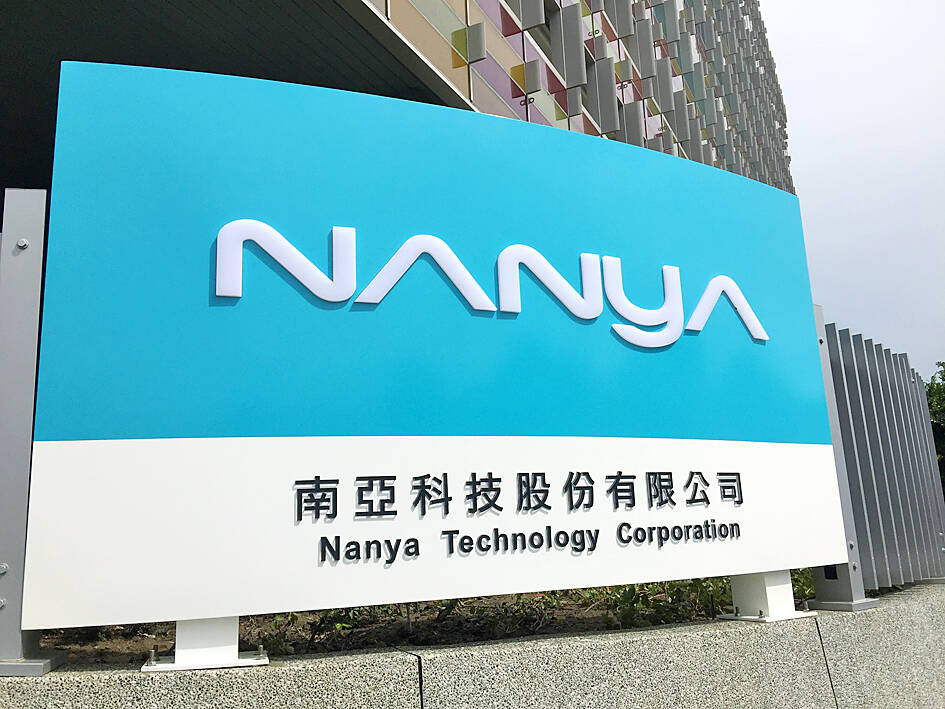Nanya Technology Corp (南亞科技) shares rallied nearly 4 percent during early trading yesterday amid optimism that the nation’s biggest DRAM chipmaker would benefit from China’s latest ban on purchasing memory chips from Micron Technology Inc.
The restrictions are widely considered a result of an escalating technology dispute between the US and China.
Chinese firms might shift orders to non-US suppliers such as Nanya Technology and South Korean memory chipmakers Samsung Electronics Co and SK Hynix Inc.

Photo: Grace Hung, Taipei Times
The Cyberspace Administration of China on Sunday night said that its review found that Micron’s memory chips pose serious network security risks to the country’s critical infrastructure supply chains, affecting China’s national security, the agency said in a statement on its Web site.
To safeguard its national security, Beijing said China’s major information and infrastructure operators should stop buying Micron products.
Chinese companies would be barred from using Micron’s memory chips in servers and data centers, it said.
“Based on our observation, about 10 percent of Micron’s revenue will be affected, if Micron lost all orders of DRAM and NAND memory chips for networking, servers and cloud devices, as well as all local government clients,” Taipei-based market researcher TrendForce Corp (集邦科技) said in an e-mail.
“Overall, the restrictions will not lead to any major changes in the landscape of the world’s memory chip industry. It will not alter the current supply-demand dynamics,” TrendForce said. “Production in China accounts for only a small portion of Micron’s total production. Chinese business also makes up a minor part.”
If Micron’s Chinese clients turn to non-US memory chip suppliers to make up for the shortfall, the cut for each supplier would be minimal, given the small pie, TrendForce said.
“We do not expect any drastic changes to happen to the memory chip industry,” it said.
Nanya Technology makes about 60 to 70 percent of its revenue from DRAM chips used in consumer electronics such as televisions, set-top boxes, network devices and vehicles.
Nanya Technology is relatively new to the server DRAM chip business, which only constituted 6 to 8 percent of its revenue last quarter.
Shares of Nanya Technology closed up 0.29 percent at NT$70.10 in Taipei trading yesterday, while shares of Powertech Technology Inc (力成科技), which provides memory chip testing and packaging services in China for Micron, dipped 1.15 percent to NT$94.90.

SETBACK: Apple’s India iPhone push has been disrupted after Foxconn recalled hundreds of Chinese engineers, amid Beijing’s attempts to curb tech transfers Apple Inc assembly partner Hon Hai Precision Industry Co (鴻海精密), also known internationally as Foxconn Technology Group (富士康科技集團), has recalled about 300 Chinese engineers from a factory in India, the latest setback for the iPhone maker’s push to rapidly expand in the country. The extraction of Chinese workers from the factory of Yuzhan Technology (India) Private Ltd, a Hon Hai component unit, in southern Tamil Nadu state, is the second such move in a few months. The company has started flying in Taiwanese engineers to replace staff leaving, people familiar with the matter said, asking not to be named, as the

The prices of gasoline and diesel at domestic fuel stations are to rise NT$0.1 and NT$0.4 per liter this week respectively, after international crude oil prices rose last week, CPC Corp, Taiwan (台灣中油) and Formosa Petrochemical Corp (台塑石化) announced yesterday. Effective today, gasoline prices at CPC and Formosa stations are to rise to NT$27.3, NT$28.8 and NT$30.8 per liter for 92, 95 and 98-octane unleaded gasoline respectively, the companies said in separate statements. The price of premium diesel is to rise to NT$26.2 per liter at CPC stations and NT$26 at Formosa pumps, they said. The announcements came after international crude oil prices

A German company is putting used electric vehicle batteries to new use by stacking them into fridge-size units that homes and businesses can use to store their excess solar and wind energy. This week, the company Voltfang — which means “catching volts” — opened its first industrial site in Aachen, Germany, near the Belgian and Dutch borders. With about 100 staff, Voltfang says it is the biggest facility of its kind in Europe in the budding sector of refurbishing lithium-ion batteries. Its CEO David Oudsandji hopes it would help Europe’s biggest economy ween itself off fossil fuels and increasingly rely on climate-friendly renewables. While

SinoPac Financial Holdings Co (永豐金控) is weighing whether to add a life insurance business to its portfolio, but would tread cautiously after completing three acquisitions in quick succession, president Stanley Chu (朱士廷) said yesterday. “We are carefully considering whether life insurance should play a role in SinoPac’s business map,” Chu told reporters ahead of an earnings conference. “Our priority is to ensure the success of the deals we have already made, even though we are tracking some possible targets.” Local media have reported that Mercuries Life Insurance Co (三商美邦人壽), which is seeking buyers amid financial strains, has invited three financial